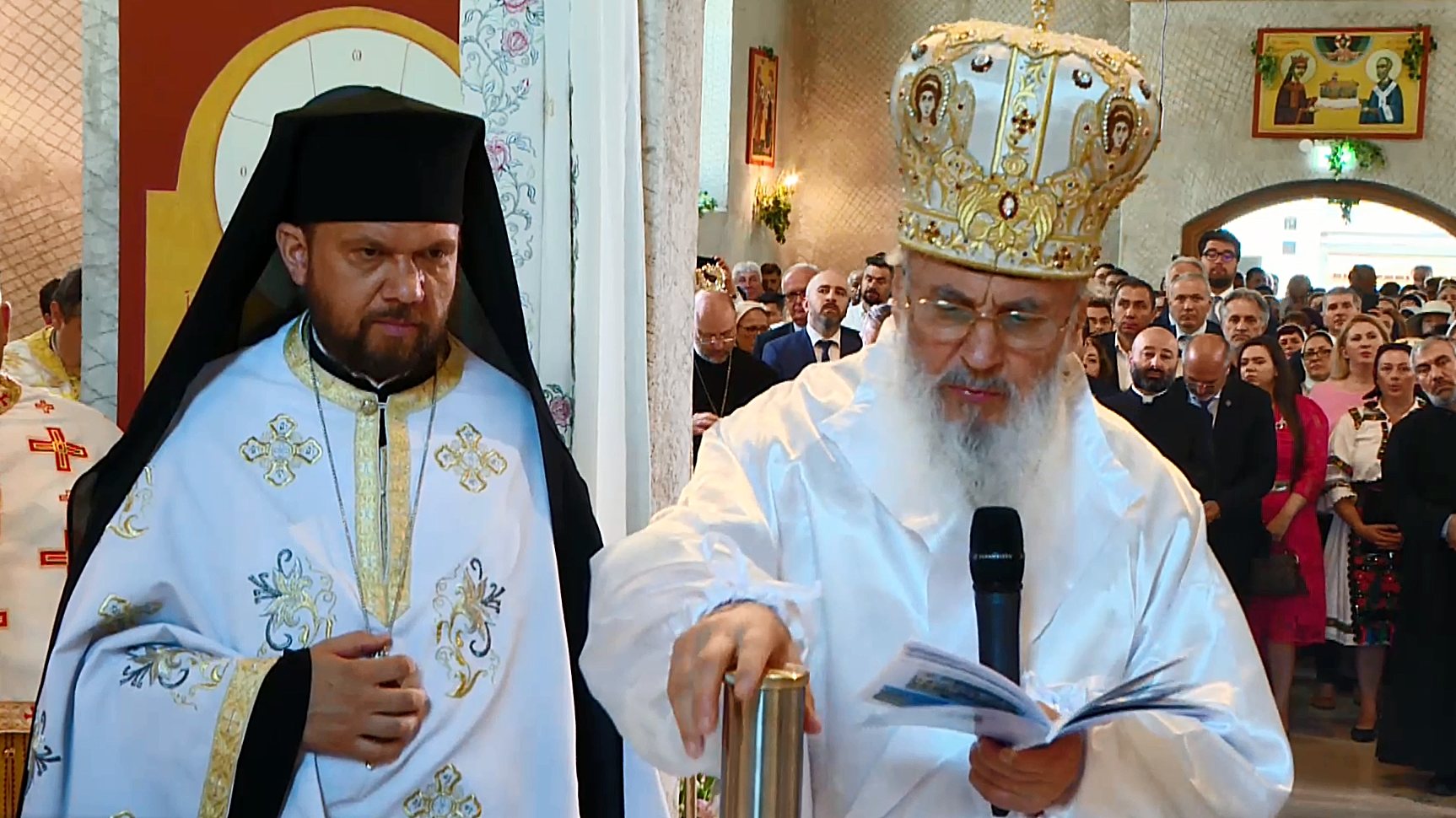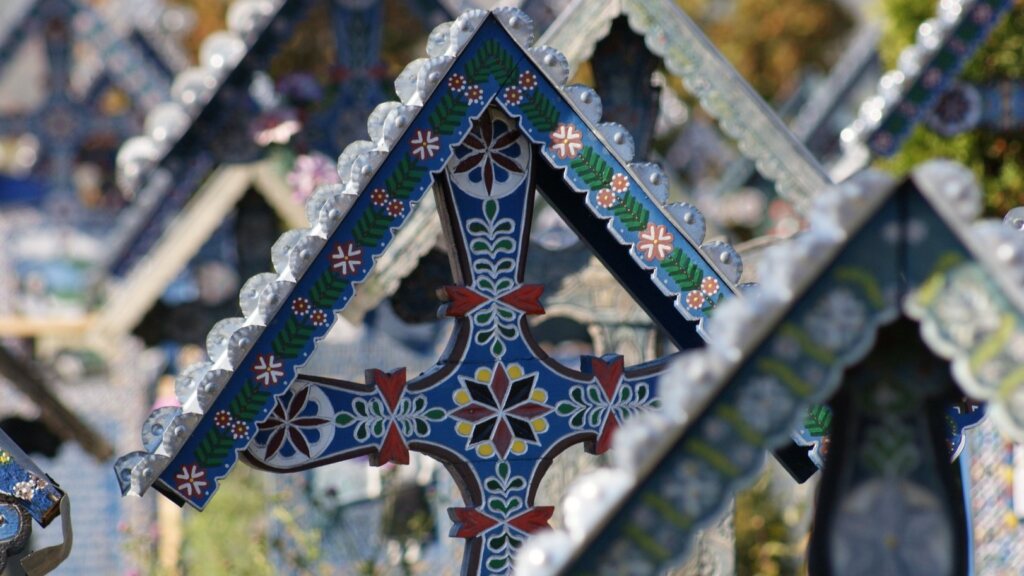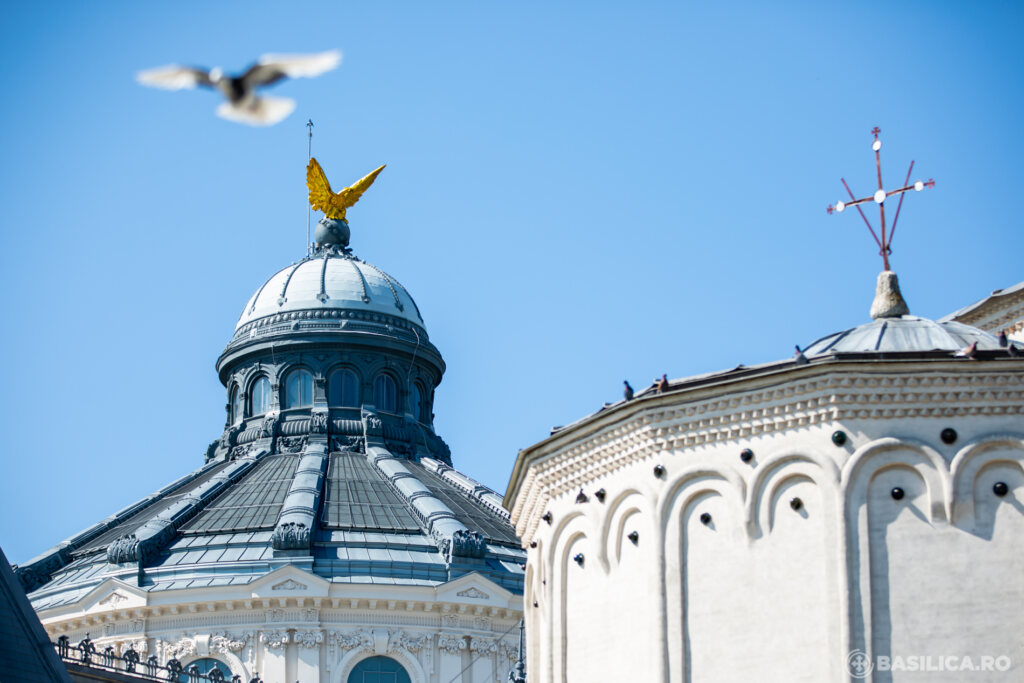His Eminence Metropolitan Serafim of Germany, Central and Northern Europe, consecrated on Saturday the altar of the Romanian Church dedicated to the Descent of the Holy Spirit and St Stephen the Great in Vienna, which he said is “a symbol of the faith and worthiness of our people on Austrian soil.”
Five hierarchs concelebrated with Metropolitan Serafim, including His Eminence Metropolitan Arsenios Kardamakis of Austria, Exarch of Hungary and Central Europe (Ecumenical Patriarchate), His Grace Bishop Macarie of Northern Europe, Patriarchal Auxiliary Bishop Varlaam of Ploieşti, His Grace Assistant Bishop Sofian of Brasov (Romanian Orthodox Archdiocese of Germany, Austria and Luxembourg), and His Grace Assistant Bishop Emilian of Crișana (Arad Archdiocese).
Abbots of monasteries in Bukovina, His Excellency Emil Hurezeanu, the Ambassador of Romania to the Republic of Austria, representatives of Vienna’s Sector 2 City Hall, and dozens of Romanian priests, benefactors and believers also participated.
The liturgical answers were offered by members of the Tronos Byzantine Choir of the Patriarchal Cathedral, led by Archdeacon Mihail Bucă, and by the parish choir “Saint Stephen the Great”, led by the Deacon Theodore Coresi and Dr Catarina Coresi Lal.
In his homily, Metropolitan Serafin referred to the theological and spiritual significance of the architecture of an Orthodox church.
The church structure, a mysterious ascent
“The altar of a church is its holiest place, the Holy of Holies. But, as we know, Orthodoxy has a deep sense of mystery, of the sacred present in the church’s architecture, in icons and frescoes, in the ritual of services and in vocal music. Everything in the Church has a meaning, a symbol, which sends us to the highest reality of the heavenly world,” the Romanian Metropolitan of Germany said.

“An Orthodox church generally consists of three parts: the narthex, the nave and the altar, which symbolize the three Persons of the Holy Trinity. The narthex symbolizes the Holy Spirit, under whose inner impulse we come to church, to unite with Christ in the Sacrament of the Eucharist.
From the narthex, we walk to the nave, the symbol of the Son, and from the nave, we advance to the Holy Altar, the symbol of the Father. It is a mysterious ascension,” His Eminence explained.
“The Holy Spirit leads us to the Son, and the Son shows us the Father. If the Son of God revealed Himself to the world through His incarnation, and the Holy Spirit through His Descent at Pentecost in the form of tongues of fire, God the Father remains shrouded in the mystery of the Holy Altar, the Holy of Holies.”
“Without a close connection with the Church, without prayer and restraint from the pleasures of the body, the soul becomes passionate about the things of this world, becomes carnal and insensitive to the mysteries surrounding us,” His Eminence Metropolitan Serafim noted.

“The church is our life, the life of Christians. Nowhere in the world does our soul feel better, more protected and enveloped by the presence of God as in the church. Only in church, in prayer, do we relieve ourselves of the pains and sorrows we accumulate in everyday life,” the Metropolitan of Germany added.
“Only in the church do we learn to love God truly and one another, because only the Church truly helps us socialize and makes us sensitive to the needs of our fellows.”
“A society without religion, without the Church, is doomed to decay and perish. Therefore, I urge you to love the Church, to pray fervently in the church, with the necessary attention, so that all prayer and singing may enter your heart and be filled with the Holy Spirit,” His Eminence said.
Metropolitan Serafim thanked the faithful and the parish priest “for the sacrifice of building this church, a symbol of the faith and worthiness of our people on Austrian soil, where a plethora of Romanians have studied and worked for centuries.”
“We would also like to thank the authorities of the city of Vienna, who welcomed our request to have a representative church, which would enrich the spiritual and cultural heritage of the Austrian capital,” the Metropolitan added.
The Romanian Metropolitan also thanked the Roman Catholic Church and Cardinal Christoph Schönborn, the Catholic Archbishop of Vienna, “for the moral and material support provided to the Romanian Orthodox communities in Austria.”
“Last but not least, we thank all our priests in Austria who are working hard for the spiritual care of the faithful and for each to have their place of worship,” Metropolitan Serafim said, ending his speech.
Emblem of the beautiful collaboration with the Viennese authorities
Patriarchal Auxiliary Bishop Varlaam of Ploiești read Patriarch Daniel’s message for the consecration of the altar of St. Stephen the Great Church in Vienna.
“This church was built in a short time (2018-2021), during the difficult period of the Coronavirus pandemic, but also providentially during 2021, consecrated by the Holy Synod of the Romanian Orthodox Church as Solemn Year of the pastoral care of Romanians abroad,” the Patriarch of Romania said in his official message.
The Romanian Patriarch appreciated that the project is “an emblem of the beautiful collaboration with the Viennese authorities”, and the pilgrimage office of the parish, which will collaborate with the Basilica Travel Agency of the Romanian Patriarchate, offering religious tourism services also for Austrian citizens, will be the opportunity to make new friends and show the beauty and spiritual richness of Romania.
Several awards were presented as a token of recognition for their involvement in the church building project.
Distinctions offered by the Romanian Patriarchate
The order “Saint John Jacob of Neamt, the New Chosebite” for clerics
- Parish Priest Emanuel-Ștefan Nuțu, “St. Stephen the Great” Church in Vienna
Order “Sanctus Stephanus Magnus” for lay people
- Georg Baldass and Mihaela Lucia Ionescu, architects;
- City Hall of Sector 2 of Vienna (Leopoldstadt);
- Maged and Maria Mihail family;
- Daniel Pițurlea, general manager of the CONCELEX construction company, who also executed the works at the “St. Stephen the Great” Church in Vienna, but also at the Church Centre in Munich;
- Josef Klein.
Distinctions offered by the Romanian Metropolis of Germany
Diploma of benefactor
- Dr Aurelia Braneti;
- Franz Schmidt;
- Cornel and Cristina Creţu family, who sent from Gura Humorului the sand necessary for the plastering of the church, so that it could be prepared for the application of painting in the fresco technique.
In turn, the parish priest offered each present hierarch an epigonation with the image of Saint Stephen the Great.

The consecration service was live-streamed on Facebook.
Manifestations on the consecration of “St. Stephen the Great” Church in Vienna continued on Sunday with the celebration of the first patronal feast of the newly consecrated church and the inauguration of the church shop and the parish’s pilgrimage office.
Brief history
The cornerstone of the “St. Stephen the Great” Church in Vienna was laid by Metropolitan Serafim in 2017. Construction works began in November 2018. The church will be painted in fresco on the outside and inside walls, thus becoming a Viennese replica of Voroneț Monastery.
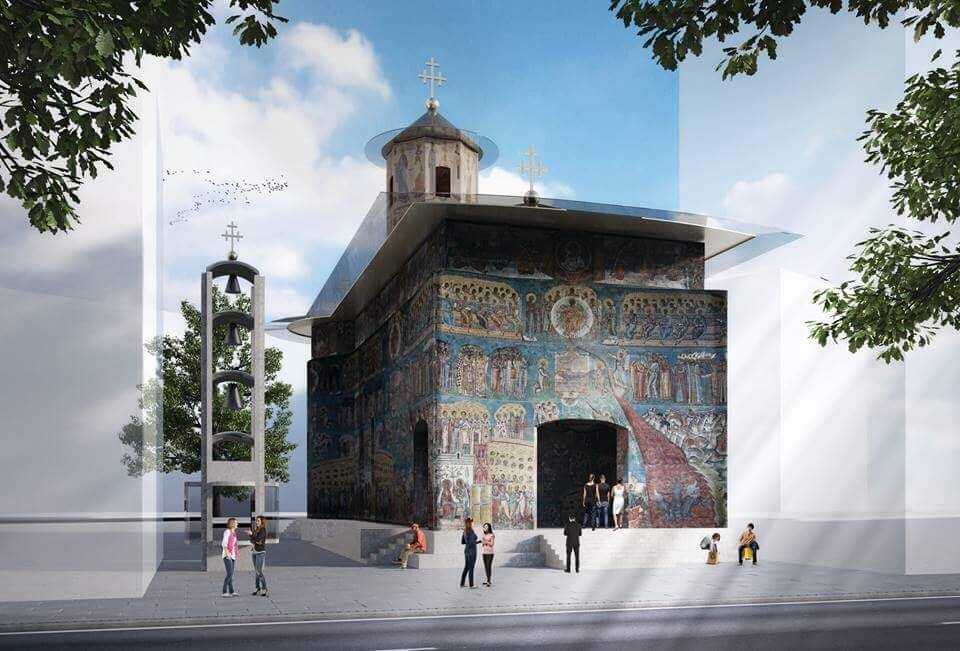
“I think there were over 100 meetings (with local authorities) in which we explained what we wanted, we brought a lot of photos, albums with monasteries, so that the officials here understand what we want to do,” Parish Priest Emanuel Nuțu told Trinitas TV.
The collaboration with the local authorities was exemplary, especially since their trust was already earned. Vienna’s Sector 2 City Hall has recently supported the construction of a block of flats with 47 apartments for the Romanian community in the district.
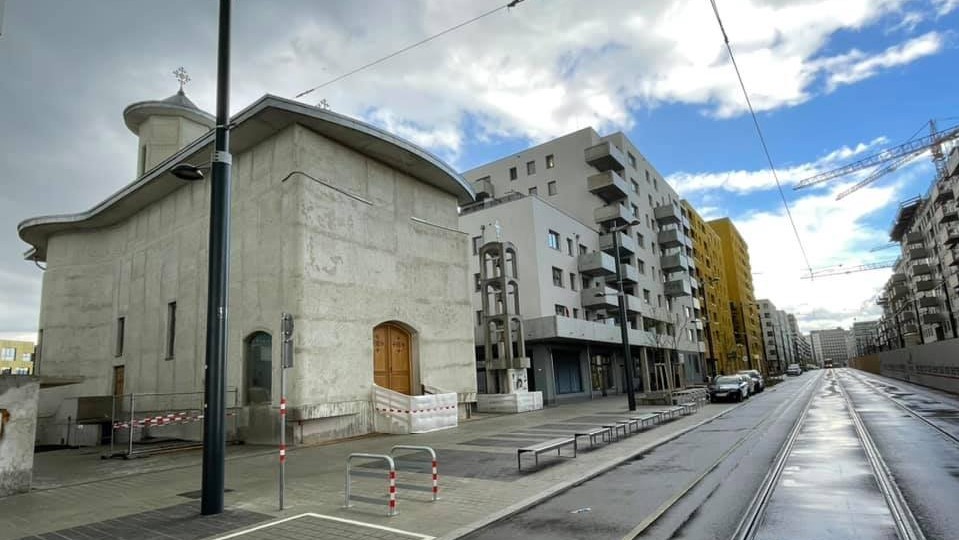
The Church of the Descent of the Holy Spirit and St. Stephen the Great in Vienna, located at 7b Bruno-Marek-Allee Street, is the third church built by Romanian Orthodox believers in the Austrian capital. The two other are “The Holy Resurrection” and “St. Andrew the First-Called” Church, and Sts. Anthony the Great and Andrew Șaguna Church.
The “Holy Resurrection” Parish in Vienna also administers a chapel at Dumitru Staniloae Religious and Cultural Centre. This is the first Romanian shrine in Vienna, where four patriarchs served. King Carol I, Queen Mary and Princess Ileana also prayed there.
Please see below the map of all the parishes in the Romanian Orthodox Archdiocese of Germany, Austria and Luxembourg:
How you can donate
Parish: Rumänisch-Orthodoxe Kirchengemeinde in Österreich
Bank: Bank Austria
Account: AT101200010014231202
BIC: BKAUATWW
Details: Kirchenbau
https://twitter.com/basilicanewsFollow us on Twitter: @BasilicaNews
